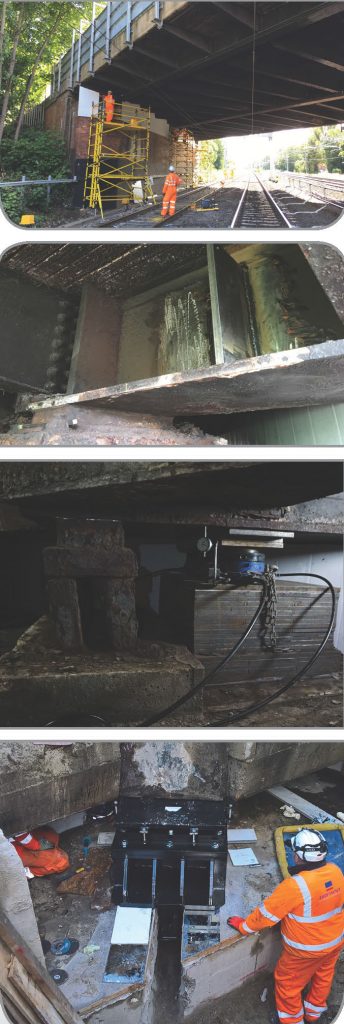 Jacking and Bearing Replacement – Uxbridge Road, Slough
Jacking and Bearing Replacement – Uxbridge Road, Slough
Client
Network Rail
Contractor
Carillion
Engineer
Tony Gee and Partners
Works Commenced
August 2017
DOWNLOAD CASE STUDY PDF HERE
Uxbridge Road bridge carries the A416 duel carriageway over the four tracks of the Great Western Line east of Slough station. It is a single span steel girder bridge crossing the railway at a skew of 50 degrees. The skew span is 29.3m, and the width is 21.0m. Decades of neglect had allowed the bearings to deteriorate badly and Freyssinet’s contract was to jack the bridge and replace the six bearings.
The two bearings beneath the central girder were the largest, measuring 915 x 685 x 250mm high. At the south side the original bearing was a 675mm high pendulum-type rocker bearing. As the new bearing was so much shallower, a steel stool measuring 915 x 900 x 400mm high was positioned beneath it. In order to transfer the transverse forces into the abutments, two 500mm deep steel studs protruded from the base of the stool.
The construction sequence entailed:
- Freyssinet welds stiffeners into girder at jacking positions and grinds out weld fixing top plate of bearing to underside of girder during Saturday night possessions.
- Principal Contractor Carillion takes a closure of the two central road lanes and excavates a 5 x 4 x 3m deep access pit behind the north and south ends of the central girder and removes ballast wall to provide access to ends of girder.
- Freyssinet installs stack of shim plates with CLP1602 (160 tonne capacity) jacks and then jacks the bridge 1mm in order to transfer the reaction off of the existing bearing.
- Freyssinet breaks out the bearing plinth with jack hammers and removes old bearing.
- Freyssinet cores 300mm diameter x 1800mm long cores horizontally into the rear face of the bearing shelf to form a 600mm deep trench to accommodate the stool studs.
- Freyssinet positions bearing and stool together (1.5t combined weight) using fork attachment on a 17t excavator. The bearing is landed on strips of PTFE on stainless steel to allow it to be easily manoeuvred into position.
- Freyssinet raises bearing to contact with underside of girder using wedge jacks and welds top plate of bearing to underside of girder.
- Freyssinet concretes the stool studs within the trench, then grouts under the bearing.
- Freyssinet dejacks, removes the shims and the jacks.
- Carillion rebuilds ballast wall, backfills pit and reopens road fully.
- Traffic is later switched to the inner lanes and the process repeated, first for the two west girder bearings and then the two on the east.
